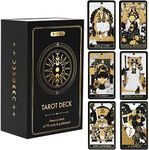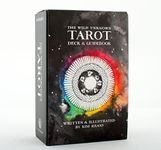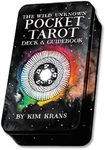Buying Guide for the Best Tarot Decks
Choosing a tarot deck is a personal journey, as the right deck should feel comfortable and inspiring to you. While the artwork and symbolism are important, it's also essential to consider how the deck fits your reading style and level of experience. Take your time to explore different options, and remember that the best deck is the one that resonates with you and supports your intuition.Artwork StyleThe artwork style refers to the visual design and imagery on the cards. This is important because tarot is a visual tool, and the images should speak to you and help you connect with the meanings. Artwork can range from traditional and classic to modern, abstract, or whimsical. If you prefer clear symbolism and easy-to-read images, a traditional or classic style might suit you. If you are drawn to creativity and unique interpretations, a modern or abstract deck could be more appealing. Choose a style that inspires you and makes you want to use the deck regularly.
Card SystemThe card system refers to the structure and tradition the deck follows, such as Rider-Waite-Smith, Thoth, or Marseille. This is important because each system has its own symbolism and way of interpreting the cards. Rider-Waite-Smith is the most popular and beginner-friendly, with clear imagery and widely available learning resources. Thoth and Marseille decks have different symbolism and may appeal to those with more experience or specific interests. If you are new to tarot, starting with a Rider-Waite-Smith-based deck can make learning easier. If you have experience or want to explore different traditions, you might choose a Thoth or Marseille deck.
Card SizeCard size refers to the physical dimensions of the cards. This matters because it affects how comfortable the deck is to shuffle and handle. Standard tarot cards are easy for most people to use, but some decks come in larger or smaller sizes. Larger cards can showcase more detailed artwork but may be harder to shuffle, especially for smaller hands. Smaller or pocket-sized decks are more portable and easier to handle but may have less visible detail. Consider your hand size and how you plan to use the deck—if you want to travel with it or use it for display, size can make a difference.
Guidebook QualityThe guidebook is the booklet or book that comes with the deck, explaining the meanings of the cards and sometimes offering spreads or reading tips. This is important, especially for beginners, as a clear and helpful guidebook can make learning tarot much easier. Guidebooks can range from very basic to detailed and comprehensive. If you are new to tarot, look for a deck with a thorough and easy-to-understand guidebook. If you are more experienced, you may not need as much guidance and can focus more on the deck itself.
Card Stock and DurabilityCard stock refers to the thickness and quality of the paper or material used for the cards. Durability is important because tarot decks are often shuffled and handled frequently. Thicker, high-quality card stock will last longer and feel more substantial, but may be harder to shuffle. Thinner cards are easier to shuffle but may wear out faster. If you plan to use your deck often, look for one with sturdy card stock. If you value easy shuffling or plan to use the deck occasionally, a lighter card stock may be fine.
Theme and SymbolismThe theme and symbolism of a deck refer to the overall concept or story that ties the cards together, such as nature, mythology, animals, or fantasy. This is important because a theme that resonates with you can make readings more meaningful and enjoyable. Some decks stick closely to traditional symbolism, while others reinterpret the cards in creative ways. Think about what themes inspire you or feel relevant to your life, and choose a deck that reflects those interests.
















